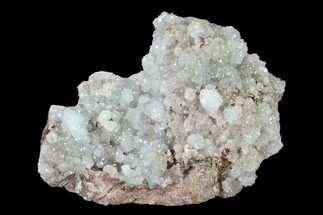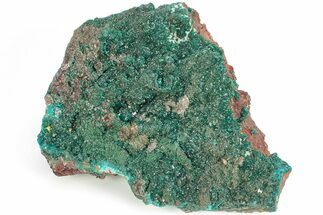This Specimen has been sold.
4.5" Lustrous Hemimorphite Crystal Cluster with Mimetite - Congo
This is a lustrous formation of light blue hemimorphite crystals and yellow mimetite. This specimen was collected from M'fouati in the Bouenza Department of the Republic of the Congo.
It comes with an acrylic display stand.
It comes with an acrylic display stand.
Hemimorphite is a basic hydrous zinc silicate with the chemical composition Zn4Si2O7(OH)2 · H2O. It earned its name from the Greek terms that best define its crystal structure. It has two different terminations on each side of the crystal, hence the inclusion of the greek terms "hemi", meaning half, and "morph", meaning shape. The crystal formations can range anywhere between a crystal druze or botryoidal formation to radiating acicular crystals and more. Hemimorphite has been found in shades of white, beige, light brown, and a bright, electric blue. It can also form as yellow and green crystals on rare occasions.
Prior to 1803, hemimorphite and smithsonite were thought to be the same mineral, called "calamine". However, further scientific research concluded that these were two distinct minerals.
Prior to 1803, hemimorphite and smithsonite were thought to be the same mineral, called "calamine". However, further scientific research concluded that these were two distinct minerals.
About Mimetite
Mimetite is a rare lead arsenate chloride mineral, often found in shades ranging from bright yellow to orange, brown, and occasionally green. Its crystals form in a hexagonal structure, typically appearing as prismatic or rounded barrel shapes, though they can also form in botryoidal or globular clusters. This mineral belongs to the apatite group and is closely related to pyromorphite and vanadinite, with which it can sometimes be found in mixed forms. Mimetite's vibrant colors and crystal formations make it a popular specimen among mineral collectors, as it is often highly aesthetic and eye-catching.
This mineral is usually found in the oxidized zones of lead ore deposits, commonly associated with minerals such as galena, wulfenite, and cerussite. It can be found in notable deposits worldwide, including locations in Mexico, Namibia, and Australia, where large and well-formed specimens have been unearthed. Mimetite crystals are relatively fragile due to their lead and arsenic content, requiring careful handling. Despite its appeal, mimetite is not used in jewelry or as a decorative stone because of its toxic elements, making it mainly a collector's mineral.
Mimetite is a rare lead arsenate chloride mineral, often found in shades ranging from bright yellow to orange, brown, and occasionally green. Its crystals form in a hexagonal structure, typically appearing as prismatic or rounded barrel shapes, though they can also form in botryoidal or globular clusters. This mineral belongs to the apatite group and is closely related to pyromorphite and vanadinite, with which it can sometimes be found in mixed forms. Mimetite's vibrant colors and crystal formations make it a popular specimen among mineral collectors, as it is often highly aesthetic and eye-catching.
This mineral is usually found in the oxidized zones of lead ore deposits, commonly associated with minerals such as galena, wulfenite, and cerussite. It can be found in notable deposits worldwide, including locations in Mexico, Namibia, and Australia, where large and well-formed specimens have been unearthed. Mimetite crystals are relatively fragile due to their lead and arsenic content, requiring careful handling. Despite its appeal, mimetite is not used in jewelry or as a decorative stone because of its toxic elements, making it mainly a collector's mineral.
SPECIES
Hemimorphite & Mimetite
LOCATION
M'fouati, Bouenza Department, Republic of the Congo
SIZE
4.5 x 2.4"
CATEGORY
ITEM
#148443
 Reviews
Reviews













